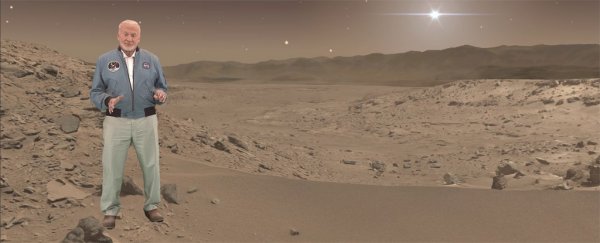The blockbuster success of The Martian gave movie-going audiences perhaps the most perfectly realised depiction yet of what living on Mars might actually be like, but a new interactive exhibit designed by NASA and Microsoft is set to bring us even closer to the experience of setting foot on the red planet.
Destination: Mars is a new 'mixed reality' exhibit opening in the US summer at NASA's Kennedy Space Centre Visitor Complex in Florida. But what's mixed reality, I hear you ask? In this case, it's pretty much the same experience as augmented reality – best demonstrated by Microsoft's HoloLens visors – except with real-world elements blended into the virtual scenery.
The effect will be the most authentic way of experiencing the red planet short of physically making the trek to Mars yourself, says NASA. The virtual environments are actually careful reconstructions of actual Mars imagery recorded by the Curiosity rover.
Curiosity has been exploring Mars since August 2012, and while the unit's chief mission is obviously scientific study of the planet's landscape, it's effectively been moonlighting all the while: scouting locations for this awesome-looking tourist attraction.
"This experience lets the public explore Mars in an entirely new way," said visualisation producer Doug Ellison from NASA's Jet Propulsion Laboratory. "To walk through the exact landscape that Curiosity is roving across puts its achievements and discoveries into beautiful context."
 NASA/JPL-Caltech/Microsoft
NASA/JPL-Caltech/Microsoft
And Curiosity isn't the only recognisable NASA figure that's part of this new virtual experience. Former astronaut Buzz Aldrin plays the role of a holographic tour guide in Destination: Mars, alongside one of Curiosity's drivers, Erisa Hines, who will explain the science behind the Martian terrain as you explore.
But while Destination: Mars sounds like a whole lot of fun, it's not just an exhibit for the public. The Microsoft-based technology powering the whole shebang is an adaptation of a serious NASA support tool called OnSight, which is used by the Curiosity team to visualise and study the lay of the land on the red planet, helping them decide which aspects the rover should pay closer attention to.
"OnSight makes the whole process of analysing the data feel a lot more natural to me," said Curiosity science team member Abigail Fraeman. "It really gives me the sense that I'm in the field when I put it on. Thinking about Martian geology is a lot more intuitive when I can stand in the scene and walk around the way I would if I were in the field."
To get a sense of what Destination: Mars will be like, check out this NASA video below, which gives you an impression of the holographic environments, plus also a sneak-peek at how the mixed reality experience incorporates physical objects.
We think this will be pretty great when it opens, and it's not far off now.
